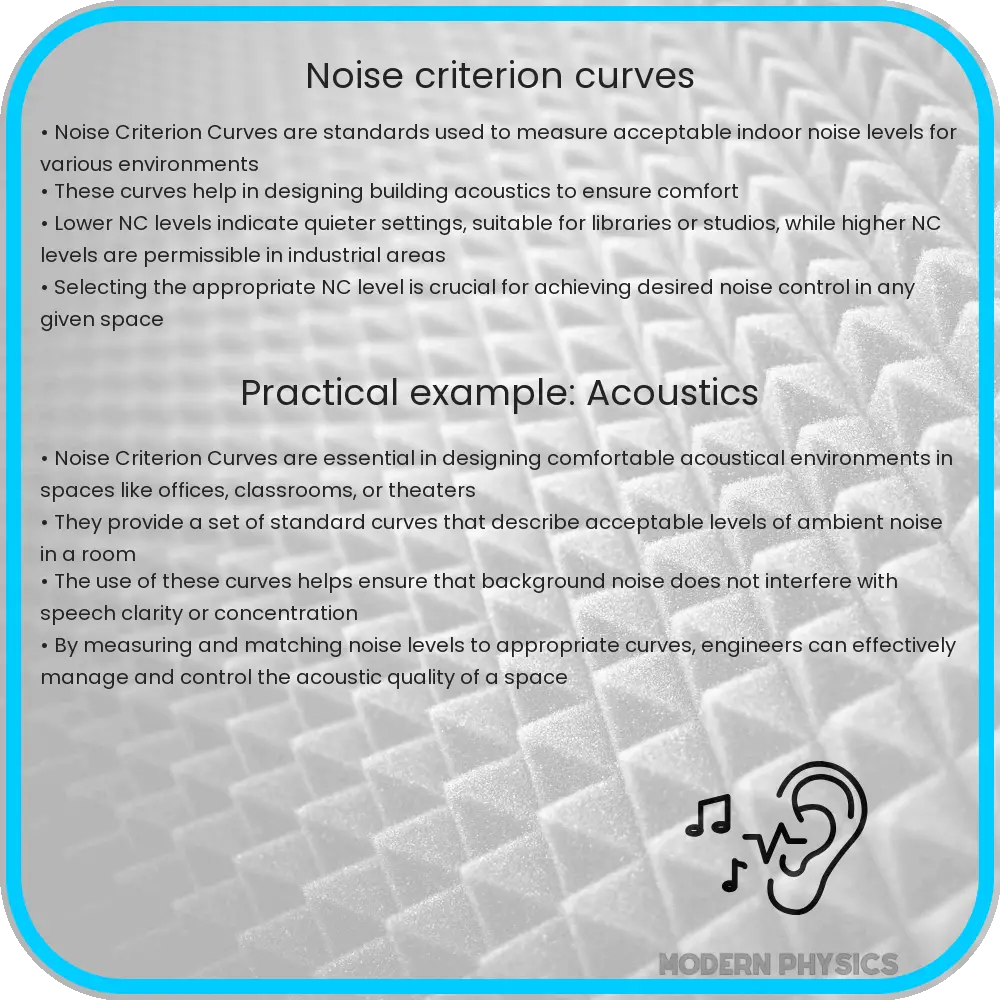Learn about Noise Criterion (NC) curves, essential tools in acoustical engineering for evaluating indoor noise levels in various environments.

Understanding Noise Criterion Curves in Acoustics
The study of sound in various environments is a crucial aspect of both workplace design and urban planning. An essential tool in acoustical engineering is the Noise Criterion (NC) curves, which are used to measure and evaluate the acceptability of the noise levels in indoor environments such as offices, classrooms, and concert halls. This article explores the concept of Noise Criterion curves, their applications, and how they are measured.
What are Noise Criterion (NC) Curves?
Noise Criterion curves are graphical standards used to rate the background noise within a space, ensuring that it does not interfere with speech clarity or contribute to discomfort. Each curve on the chart represents a different noise level rated by NC. These curves are plotted across a range of frequencies typically between 63 Hz and 8000 Hz, which correspond to the range of human hearing.
Development of NC Curves
The concept of Noise Criterion was first introduced in 1957 by Leo Beranek, an American acoustician. The original set of curves, known as the NC curves, were developed to help in the design and evaluation of acoustics in building interiors where speech communication is critical. The objective was to define maximum noise levels that allow for satisfactory conditions in various types of rooms based on their use.
Applications of NC Curves
Noise Criterion curves are utilized in various applications to ensure sonic comfort and clear audibility. Here are some of the principal uses:
- Architectural Design: Architects and engineers use NC curves to assess and control the ambient noise in buildings to enhance the acoustic quality of the environment.
- HVAC System Design: Heating, ventilation, and air conditioning (HVAC) systems can be significant sources of noise. NC curves help in designing these systems to minimize their noise emission within occupied spaces.
- Educational Institutions: In schools and universities, proper acoustic environments are crucial for effective learning. NC curves guide the design of classrooms to facilitate clear teacher-student communication.
- Industrial Settings: In factories and production floors, NC curves are used to ensure that noise levels do not impede concentration or communication among workers, which is critical for safety and efficiency.
Measurement of Noise Levels Using NC Curves
To apply Noise Criterion curves effectively, it’s important to measure the existing noise levels accurately at different frequencies. The procedure involves using a sound level meter equipped with an octave band filter to collect noise data across the requisite frequencies. This data is then plotted against the NC curves to determine the corresponding NC rating. If the ambient noise surpasses the acceptable curve, noise mitigation strategies must be employed to bring the noise levels within acceptable limits.
The impact of noise on human activity can be significant, and managing it requires precise tools and understanding. Noise Criterion curves provide a standard by which acoustics can be managed to create environments that are conducive to their intended use. In the next section, we will delve deeper into how these curves are analyzed and how they are practically implemented in different scenarios.
Analysis and Implementation of NC Curves
The analysis of NC curves is crucial for ensuring that the noise levels within an environment are conducive to its intended use. By comparing measured noise levels with the NC curves, acousticians can objectively determine the noise class of a space. These classes range from NC-15, indicative of a very quiet space like a recording studio, up to NC-70, which would be typical in a heavy industrial environment.
Practical implementation of NC curves starts with identifying the functional requirements of the space. For instance, a conference room would require lower NC values to facilitate clear verbal communication. Once the ideal NC level is determined, acousticians and engineers implement design strategies such as soundproofing panels, optimized HVAC systems, and carefully designed ceiling and floor materials to achieve these targets.
Noise Mitigation Strategies
When existing noise levels exceed the acceptable limits as outlined by the NC curves, various noise mitigation strategies are necessary. These may include:
- Architectural Modifications: Changing the layout or materials used in a building to improve sound absorption and reduce noise transmission.
- Installing Sound Barriers: This includes adding acoustic panels or insulation to walls, ceilings, and floors to dampen sound transmission.
- Upgrading HVAC Systems: Replacing or modifying heating, cooling, and ventilation systems to operate more quietly and efficiently.
- Implementing Noise Control Policies: Creating rules that limit the use of loud machinery during certain hours or in proximity to sensitive areas.
Conclusion
Noise Criterion curves are an indispensable tool in the field of acoustical engineering, serving a critical role in the design and assessment of indoor environments. From enhancing the acoustic comfort of commercial and educational buildings to ensuring communication clarity in industrial settings, the proper application of NC curves has a direct impact on the functionality and usability of spaces. By understanding and implementing these curves, together with effective noise mitigation strategies, architects, engineers, and urban planners can create environments that are not only functionally optimized but also comfortable and conducive to their intended purposes. Through careful measurement and analysis of noise levels, aided by the strategic use of NC curves, modern acoustics continues to improve the spaces in which we live and work, making our environments more agreeable and effective for various activities.
